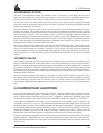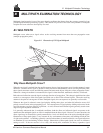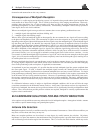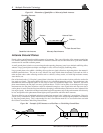
A GPS Overview
60 MiLLennium Command Descriptions Manual
ADR
double difference
= (ADR
rx A,sat i
- ADR
rx A,sat j
) - (ADR
rx B,sat i
- ADR
rx B,sat j
)
An ambiguity value is estimated for each double-difference observation. One satellite is common to every satellite
pair; it is called the reference satellite, and it is generally the one with the highest elevation. In this way, if there
are n satellites in view by both receivers, then there will be n-1 satellite pairs. The difference between receivers A
and B removes the correlated noise effects, and the difference between the different satellites removes each
receiver’s clock bias from the solution.
In the NovAtel RTK system, a floating (or “continuous-valued”) ambiguity solution is continuously generated
from a Kalman filter. When possible, fixed-integer ambiguity solutions are also computed because they are more
accurate, and produce more robust standard-deviation estimates. Each possible discrete ambiguity value for an
observation defines one lane; that is, each lane corresponds to a possible pseudorange value. There are a large
number of possible lane combinations, and a receiver has to analyse each possibility in order to select the correct
one. For single-frequency receivers, there is no alternative to this brute-force approach. However, one advantage
of being able to make both L1 and L2 measurements is that linear combinations of the measurements made at both
frequencies lead to additional values with either “wider” or “narrower” lanes. Fewer and wider lanes make it easier
for the software to choose the correct lane, having used the floating solution for initialization. Once the correct
wide lane has been selected, the software searches for the correct narrow lane. Thus, the searching process can
more rapidly and accurately home in on the correct lane when dual-frequency measurements are available.
Changes in the geometry of the satellites aids in ambiguity resolution; this is especially noticeable in L1-only
solutions. In summary, NovAtel’s RTK system permits L1/L2 receivers to choose integer lanes while forcing L1-
only receivers to rely exclusively on the floating ambiguity solution.
Once the ambiguities are known, it is possible to solve for the vector from the reference station to the remote
station. This baseline vector, when added to the position of the reference station, yields the position of the remote
station.
In the NovAtel RTK system, the floating ambiguity and the integer position solutions (when both are available) are
continuously compared for integrity purposes. The better one is chosen and output in the receiver’s matched-
position logs. The “best” ambiguities determined are used with the remote station’s local observations and a
reference station observation model to generate the remote station’s low-latency observations.
NovAtel’s RTK product line consists of RT-2 and RT-20 software. Performance characteristics of each are
described in Appendix E.


















